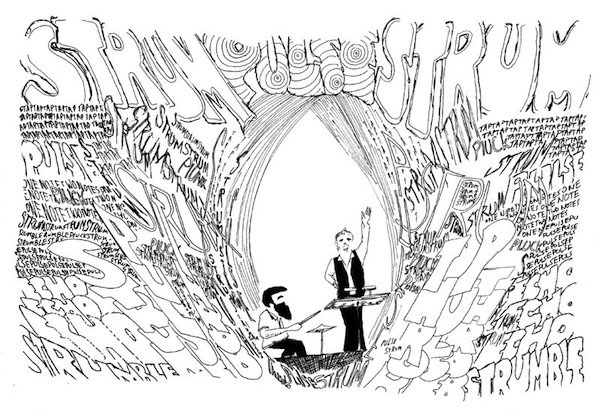
It’s safe to say that most recording engineers are musicians. Or at least were at some point. How does one end up with a career devoted to documenting musical performances if not through their own experiences creating music? I’m sure that there are some engineers out there with no musical background, but I’m sure most folks behind the boards these days started off playing in a band or recording themselves. This is probably not surprising to any of you, but what happens when an engineer’s work conflicts with his or her identity as a musician?
A special sonic experience.
First, some back story. Way back in 2009, my good friend (and fellow Early alum) Alex Lewis and I played guitar in an incredible and unique performance. We, along with 198 other guitarists, sixteen bassists, and a lone hi-hatter, gathered in Damrosch Park in New York to perform Rhys Chatham’s A Crimson Grail for the Wordless Music Series. The setup was unlike anything any of us had ever experienced (unless you count the rehearsals and cancellation of the same piece the year before): 200 electric guitars with 200 amps, surrounding the audience in a giant U shape, with four sections conducted by rad music dudes like Seth Olinsky (Akron/Family) and Ned Sublette, all coming together to produce a nearly hour-long piece of music. Yeah, a minimalist composer writing for 200 guitars, I know.
As a guitar player, this was a lot of fun. But by this point I thought of myself more as an engineer than a guitarist. As an engineer, it was an incredible learning experience because it raised some questions that forced me to think about sound in entirely new ways. How can 200 guitar amps work together to create a single, cohesive sound? In such a large and open space, how do reflections and time delays factor into the aural experience of the audience and performers? How will the positioning of the players and seating factor into how each audience member hears the performance? Despite the joy of being a performer, my mind couldn’t help but ponder these distinctly engineer-y thoughts.
That was the last time I played guitar in a live setting for over a year, until recently.
A new perspective.
Last week I had the opportunity to perform live with longtime friend and musical partner Hip Hatchet, the nom de plume of Philippe Bronchtein. Nothing much, just a few songs backing him up on acoustic guitar while he commanded the attention of a diverse crowd at a show near USC. What I didn’t count on was my guitar skills being so rusty! For some reason, I hadn’t had the time (or found the time, or made the time) to play guitar much at all over the past few months. Sure, I’d been busy working on a number of projects, but that excuse doesn’t hold any water once you look at folks like Joel Hamilton, who is a highly in-demand engineer yet still plays in Book of Knots, or Raymond Richards, who balances production and touring well.
In the time between A Crimson Grail and performing with Phil, I had somehow become accustomed to taking a break from making music outside of work-related projects. While I was in school, playing guitar was an escape from all the non-musical work I was doing. Now, I am fortunate to have a job in which I am constantly surrounded by music, but that means that guitar is no longer much of an escape. After listening and working on music in the studio all day, once I get home I am often too tired to pick up the guitar, and want to rest my body and ears.
Yesterday I realized how important it is to maintain an active musical life outside the studio. I finally received my copy of the Crimson Grail recording, and upon listening to it immediately found myself imagining how the engineer approached capturing that unconventional performance and translating it to a stereo mix. Being a participant in the performance had given me a more intimate knowledge of the music than had I just been in the audience, and that caused me to think about the recording differently. As soon as I realized this, I decided to get back to playing guitar regularly, and hopefully performing more often as well.
Share your thoughts.
What about you? Are you a musician who is just getting into recording yourself, or a longtime engineer who got your start making demos for your band? Or perhaps you’re solely a musician, choosing to leave the recording process to others? No matter your role in creating music, it no doubt informs how you think about recording and the production process. I’d love to hear your thoughts in the comments below.

